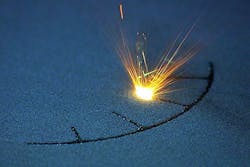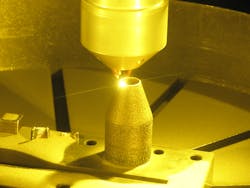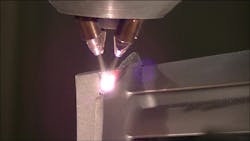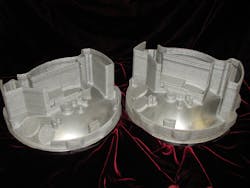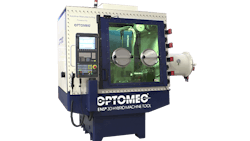Is welding the Trojan horse of metal additive manufacturing?
KENNETH VARTANIAN and PASCAL PIERRA
While metal additive manufacturing (AM) technology is gaining momentum, the level of adoption is still quite low compared to traditional subtractive metalworking methods. In 2017, only 1768 metal AM machines1 were sold worldwide compared to hundreds of thousands of computer numerical control (CNC) subtractive machine tools.
Part of the reason for the low adoption level may be the misconception that metal AM technology can be used only to 3D-print new parts, which limits its potential use. This could be because the most commonly used metal AM technology, powder bed fusion (PBF), can only 3D-print new parts built up on flat, two-dimensional (2D) plates. However, metal AM technology, such as powder-fed directed energy deposition (DED), can 3D-print new metal parts and also add materials to existing components, enabling a broader range of applications such as repair, surface modification, and hybrid manufacturing (which combines traditional metalworking processes with AM).
In essence, DED is an automated precision welding process for building or repairing parts. With the global shortage of skilled welders, industry must find new methods to make the current workforce more productive. Could welding be the Trojan horse to accelerate industrial adoption of metal AM? In this article, we present new DED applications that can make it easier to justify and deploy metal AM applications.
Technology background
Laser-based AM technology was invented in the 1980s and the two most commonly known methods available for commercial use today are powder bed fusion (PBF) and powder-fed DED systems. PBF systems use a laser to selectively melt a bed of metallic powder layer by layer to build up the physical part (FIGURE 1). After the first layer is spread and sintered, the bed is filled again with a second layer of powder and selectively sintered. This process is repeated until the part is fully formed. The end result is buried in a cake of powder and is not visible until the excess powder is removed. Powder-fed DED systems continuously blow powder through nozzles directed at the focal point of a high-power laser (FIGURE 2). The resultant molten pool of metal (sometimes referred to as a weld pool) is then moved using a motion control system and the part is built up in free space. The entire process is visible as the part is grown layer by layer.Each process has its advantages. The PBF method is better at building smaller, more complex-shaped parts and produces a better surface finish, while the powder-fed DED method is faster and better at adding material to existing parts (as in repair or hybrid manufacturing). In general, powder-fed DED technology produces fully dense material that has excellent mechanical and fatigue properties. PBF machines can be used in many cases for building small metal components, except if a functionally graded material is required or if the desired material is one not commonly processed by PBF systems. For building large parts or repairing worn or defective metal components, powder-fed DED machines, such as LENS machines offered by Optomec, are stronger candidates (TABLE).
Comparison of powder-bed fusion (PBF) and directed energy deposition (DED) features.
LENS DED process
The size of the weld bead produced with the LENS DED process can be as small as 500 µm or as large as 6 mm in diameter. This flexibility enables a range of applications, from building thin wall structures to precision repair to adding wear-resistant coatings to components. Unlike metal inert gas (MIG) or tungsten inert gas (TIG) welding, the highly targeted nature of the LENS DED process enables addition of materials to metal components with minimal heat effect to the surrounding area. Open-atmosphere LENS systems are available for companies that work exclusively with materials such as stainless and tool steels, Inconel, and other non-reactive metals. Just like in welding, an argon shield gas is used to protect the weld pool from contamination. For processing titanium, aluminum, refractories, and other reactive materials, LENS systems can be equipped with an atmosphere-controlled, hermetically sealed chamber that maintains oxygen and moisture levels below 10 ppm.
The LENS DED process also includes closed-loop feedback controls that automatically adjust laser power to maintain a constant heat input to the melt pool and cooling rate during the deposition process. A constant cooling rate is essential to quality metal deposition. Because of these process attributes and controls, materials produced with this process have excellent mechanical properties equal to or better than cast, and in many cases similar to forged materials.
Global shortage of skilled welders
According to the American Welding Society (AWS), the U.S. fabrication industry is now on course to have a shortage of 290,000 skilled welders by 2020.2 And this skilled workforce shortfall is not just a U.S. problem—the average age of welders in Australia and the UK has now surpassed 55.
The age profile of skilled welders has been skewed to the extent that shortages of welders are now an inevitable global problem.3 Experts in the field believe industry can’t train new welders fast enough to make up for shortfall. So, why is a shortage of skilled welders an important factor in driving adoption of DED AM technology? In an environment where there are not enough welding craftsmen, the only answer is to augment the skills of current and apprentice workforce with automated technology that make them more productive.
LENS DED welding applications
General Electric’s use of AM to print fuel nozzles for their LEAP engine is well known. The investment in engineering, process development, and equipment to achieve these results is beyond the reach of most smaller companies. In the long run, General Electric’s investment will provide a return on investment (ROI) through savings across the product lifecycle.
However, less well known are equally compelling applications where AM is used to repair components. For example, the U.S. Army Anniston Depot utilized LENS technology to repair engine components for the Abrams M1 tank. Operating in a desert environment, M1 tank engines, such as the Honeywell AGT1500, were experiencing extreme amounts of wear, requiring shorter interval maintenance cycles. The AGT1500 engine components are difficult to repair with traditional methods because of distortion effects caused by the high-heat welding process. With the LENS technology, a highly focused laser beam delivered energy exactly to the repair area, reducing the heat-affected zone (HAZ) to enable repair of these engine components. This process allowed Anniston to repair rather than replace worn engine components, saving over $5 million per year (FIGURE 3).Even small organizations, such a local salsa factory based in Albuquerque, NM, can benefit from LENS repair capabilities. In December 2017, 505 Southwestern Inc.’s salsa production line was shut down because of a broken helical gear. With no spare gears in stock and an eight-week lead time to deliver a replacement gear, 505 faced a significant loss in production capacity during the busy holiday season. Using the LENS technology, the Inconel helical gear was repaired and the production line was back in operation in one day.
These few examples are certainly less exciting than printing a unitized jet engine fuel nozzle, but these applications are easier to deploy and provide a faster ROI and pathway for organizations to develop more advanced AM applications for new product designs.
Breaking through the barriers
There have been many lessons learned in Optomec’s 20-year journey to commercializing AM technology. One of the biggest is that any new technology, especially a disruptive manufacturing technology such as AM, takes time to gain acceptance. This acceptance must be earned by finding cost-effective applications that provide clear advantages over existing methods.
To enable a more compelling economic justification, LENS technology was recently integrated into lower-cost CNC platforms to make LENS metal AM much more affordable, as well as more familiar and intuitive to shop floor operators. With lower-entry-level pricing, LENS DED systems offer more capability at less than half the cost of competitive 3D metal printers and are even less expensive than many automated welding systems (FIGURE 5).The risks are high for a manufacturer to implement any disruptive technology, so methods to mitigate risk can help accelerate deployment. Finding applications such as repair to extend product life or improve production yield are great examples. And the interesting thing is that when working with metal parts, an organization already uses crude AM technology in its welding department—so this new technology enables an organization to cost-effectively advance capability with precision welding while also providing a pathway to full 3D printing of new product designs.
ACKNOWLEDGEMENT
LENS is a registered trademark of Optomec.
REFERENCES
1. T. Wohlers, “Wohlers Report 2017: 3D Printing and Additive Manufacturing State of the Industry Annual Worldwide Progress Report,” ISBN 978-0-9913332-3-3 (2017).
2. J. Wilkey, “The future remains bright for skilled welders” (Nov. 11, 2015); https://goo.gl/N1wS88.
3. B. Latz, “The coming workforce crisis in welding” (May 16, 2017); https://goo.gl/f4n6hm.
KENNETH VARTANIAN ([email protected]) is vice president of marketing and PASCAL PIERRA ([email protected]) is director of Asia Pacific sales in Singapore, both at Optomec, Albuquerque, NM; www.optomec.com.
